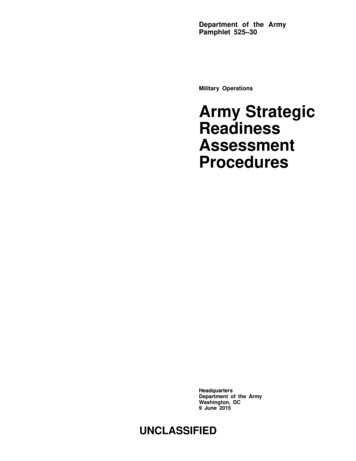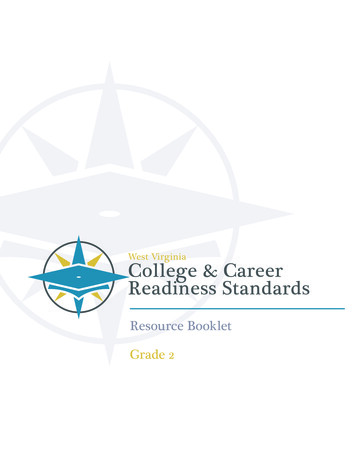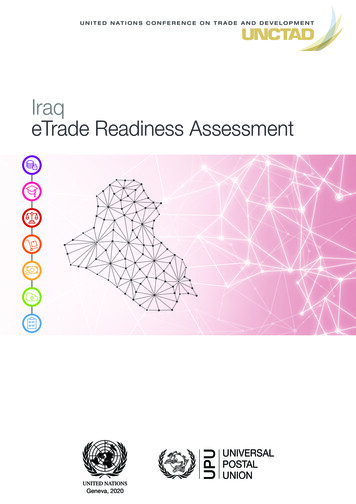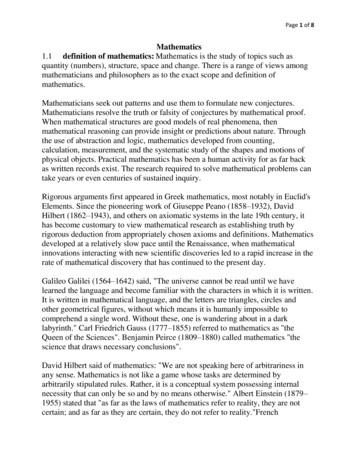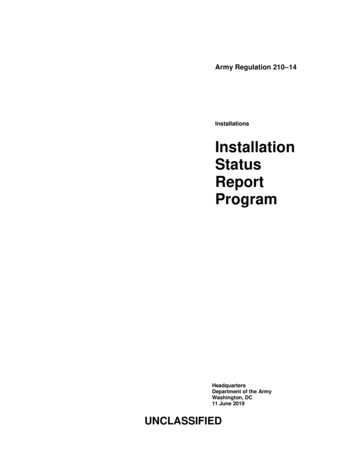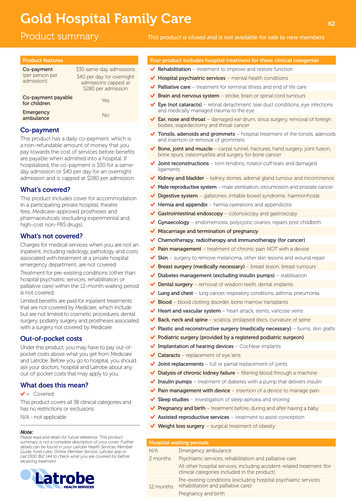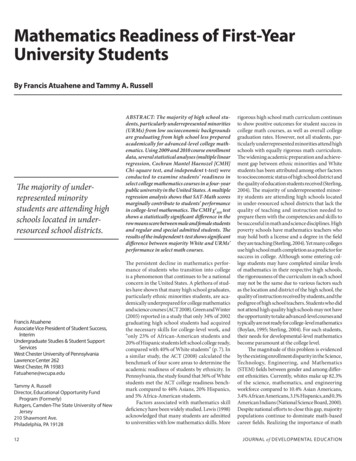
Transcription
Mathematics Readiness of First-YearUniversity StudentsBy Francis Atuahene and Tammy A. RussellThe majority of underrepresented minoritystudents are attending highschools located in underresourced school districts.Francis AtuaheneAssociate Vice President of Student Success,InterimUndergraduate Studies & Student SupportServicesWest Chester University of PennsylvaniaLawrence Center 262West Chester, PA 19383Fatuahene@wcupa.eduTammy A. RussellDirector, Educational Opportunity FundProgram (Formerly)Rutgers, Camden-The State University of NewJersey210 Shawmont Ave.Philadelphia, PA 1912812ABSTRACT: The majority of high school students, particularly underrepresented minorities(URMs) from low socioeconomic backgroundsare graduating from high school less preparedacademically for advanced-level college mathematics. Using 2009 and 2010 course enrollmentdata, several statistical analyses (multiple linearregression, Cochran Mantel Haenszel [CMH]Chi-square test, and independent t-test) wereconducted to examine students’ readiness inselect college mathematics courses in a four-yearpublic university in the United States. A multipleregression analysis shows that SAT-Math scoresmarginally contribute to students’ performancein college-level mathematics. The CMH χ2MH testshows a statistically significant difference in therow means score between male and female studentsand regular and special admitted students. Theresults of the independent t-test shows significantdifference between majority White and URMs’performance in select math courses.The persistent decline in mathematics performance of students who transition into collegeis a phenomenon that continues to be a nationalconcern in the United States. A plethora of studies have shown that many high school graduates,particularly ethnic minorities students, are academically underprepared for college mathematicsand science courses (ACT 2008). Green and Winter(2005) reported in a study that only 34% of 2002graduating high school students had acquiredthe necessary skills for college-level work, and“only 23% of African-American students and20% of Hispanic students left school college ready,compared with 40% of White students” (p. 7). Ina similar study, the ACT (2008) calculated thebenchmark of four score areas to determine theacademic readiness of students by ethnicity. InPennsylvania, the study found that 36% of Whitestudents met the ACT college readiness benchmark compared to 46% Asians, 20% Hispanics,and 5% Africa-American students.Factors associated with mathematics skilldeficiency have been widely studied. Lewis (1998)acknowledged that many students are admittedto universities with low mathematics skills. Morerigorous high school math curriculum continuesto show positive outcomes for student success incollege math courses, as well as overall collegegraduation rates. However, not all students, particularly underrepresented minorities attend highschools with equally rigorous math curriculum.The widening academic preparation and achievement gap between ethnic minorities and Whitestudents has been attributed among other factorsto socioeconomic status of high school district andthe quality of education students received (Sterling,2004). The majority of underrepresented minority students are attending high schools locatedin under-resourced school districts that lack thequality of teaching and instruction needed toprepare them with the competencies and skills tobe successful in math and science disciplines. Highpoverty schools have mathematics teachers whomay hold both a license and a degree in the fieldthey are teaching (Sterling, 2004). Yet many collegesuse high school math completion as a predictor forsuccess in college. Although some entering college students may have completed similar levelsof mathematics in their respective high schools,the rigorousness of the curriculum in each schoolmay not be the same due to various factors suchas the location and district of the high school, thequality of instruction received by students, and thepedigree of high school teachers. Students who didnot attend high quality high schools may not havethe opportunity to take advanced-level courses andtypically are not ready for college-level mathematics(Boylan, 1995; Sterling, 2004). For such students,their needs for developmental-level mathematicsbecome paramount at the college level.The magnitude of this problem is evidencedby the existing enrollment disparity in the Science,Technology, Engineering, and Mathematics(STEM) fields between gender and among different ethnicities. Currently, whites make up 82.3%of the science, mathematics, and engineeringworkforce compared to 10.4% Asian Americans,3.4% African Americans, 3.1% Hispanics, and 0.3%American Indians (National Science Board, 2000).Despite national efforts to close this gap, majoritypopulations continue to dominate math-basedcareer fields. Realizing the importance of mathJOURNAL of DEVELOPMENTAL EDUCATION
preparedness to academic success and the impact ofstudent success on college persistence and retention,this study examines first-time, full-time students’readiness for college mathematics as measured bytheir performance in select mathematics coursestaken during their first semester of enrollment ata four-year comprehensive public university.Literature ReviewVarious studies have examined success in collegelevel math (Benbow & Arjmand, 1990; Spade,Columba, & Vanfossen, 1997) using a range of variables including gender differences in math (Boaler,1997), gender and minority comparisons (Clewell,Anderson, & Thorpe, 1992), gender comparisonsin general (Adelman, 1998; Arnold, 1993; Astin &Sax, 1996; National Research Council, 1991; NSF,1996; Schaefers, Epperson, & Nauta, 1997; Yauch,1999) and first-generation and socioeconomicstatus (Ting, 1998). Other studies that focused onsuccess in specific college majors such as scienceand engineering degrees (Hewitt & Seymour, 1991;Huang, Taddese, Walter, & Peng, 2000) incorporated similar variables in their analysis.These studies suggest that minority studentsenroll in four-year degree programs academicallyless prepared than nonminority students. Highschool academic variables such as SAT and ACTthat include both verbal and math scores and highschool GPA may not adequately determine whetherstudents are equally prepared academically.Although high school academic preparation mayhave a strong association with college math performance and graduation from bachelor’s degreeprograms (Trusty, 2002; Trusty & Niles, 2003), highschool grades do not necessarily guarantee that astudent is prepared for college-level work (Choy,Henke, Alt, Medrich, & Bobbit, 1993; Dillworth,1990; Henke, Choy, Geis, & Broughman, 1996;Horn, Hafner, & Owings, 1992). Although Bailey,Jeong and Cho (2008) have suggested that math isthe subject in which skill-deficient students are lesslikely to successfully progress through college level,there are certainly possible factors other than skilldeficiency that contribute to a student’s failure, suchas the rigorousness of high school curriculum.Quality of High School MathA number of studies have investigated how thequality of high school math preparation impactssuccess at college-level mathematics (Adelman,1999; Boaler, 1997; Choy et al., 1993; Dillworth,1990; Henke et al., 1996; Horn et al., 1992; NationalCenter for Education Statistics, 1995; Weiss, Matti,& Smith, 1994). Several studies have shown thatsome students are completing high school mathematics courses assuming that those courses arecomparable to similar courses offered to other students in different schools. Horn et al. (1992) emphasized the discouraging numbers of less qualifiedVOLUME 39, ISSUE 3 SPRING 2016teachers who are more likely to instruct studentsfrom the lowest academic and socioeconomicbackgrounds. Even if students have completeda math course titled trigonometry or calculus,higher level high school math course enrollmentdoes not translate into high quality and rigorousmath curriculum to potentially support successin college-level math.Of considerable importance in the study byHorn et al. (1992) is the comparison made aboutdifferent student populations and the type of 8thgrade math completed by each student group. Intheir study, 47% of high-income students wereenrolled in 8th-grade algebra as compared to15.2% of low-income students. Furthermore, 50%of low-income students were more likely to havemath teachers who majored in general educationbachelor’s degree programs compared to 39% ofhigh-income students (Horn et al., 1992). All ofthese factors related to the likelihood of whether ornot students were placed in college developmentalmath curriculum.High school grades do notnecessarily guarantee thata student is prepared forcollege-level work.Remedial Course CompletionIn 1995, 29% of first-year students attending fouryear institutions enrolled in at least one remedialcourse (Lewis & Farris, 1996). A study by theNational Center for Education Statistics (2003)also reported that 22% of students who enrolled inremedial courses enrolled in math remediation and14% enrolled in writing remediation. Accordingto Hoyt and Sorenson (2001), despite the largenumber of students enrolling in remedial education courses some states education departmentshave tried to reduce or eliminate remedial courseofferings due to cost. Although it may take somestudents longer to complete a degree, the elimination of remedial education courses would furtherhinder the prospects of student populations whoneed the courses to prepare them to completebachelor’s degree programs (Long, 2005). Missingfrom this data are comparison studies focusing onstudents’ high school math completion and otherhigh school background information, includingthe percentage of students considered math proficient and/or economically disadvantaged at eachof the high schools and how that relates to remedialcourse completion in college.Students from low socioeconomic backgrounds tend to complete vocational curriculum more often than college-level curriculum(Rojewski, 1997). Studies by May and Chubin(2003); Tyson, Lee, Borman, and Hanson (2007);and Perna, Lundy-Wagner, Drezner, Gasman,Yoon, Bose, and Gary (2009) have reported thatAfrican-American and Hispanic students aremore likely to attend high schools that do not offeradvanced math and science courses, supportingthe need for more federally structured high schoolcurriculum requirements. More so, some of thesestudents attend high schools that offer vocationaland technical training for easy entry into the jobmarket. However, although vocational and technical curriculum are helpful with addressing highschool students’ career interests, most of theseschools lack rigorous curriculum that academically prepares students for college-level work.In an analysis of survey results of approximately 6,000 teachers in 1,200 public and privatehigh schools which appeared in a report entitledMultiplying Inequalities, Oakes (1990) argues that“[a]s the proportion of low-income and minoritystudents at a school increases, the relative proportionof college-preparatory and advanced course sectionsdecreases” (p. 35). In this analysis Oakes indicatesthe number of calculus sections available per studentin high-income schools to be approximately fourtimes greater than that of low-income schools.Chaney (1995) also found that math coursestaken beyond the minimum high school mathrequirements tend to have a stronger relationship with achievement in college mathematics.Chaney, Burgdorf, and Atash (1997) estimatedthat increased high school math requirementsresulted in increased numbers of math and sciencecourses completed but not an increase in the levelof courses. They contended that, although studentscompleted more math and science coursework inhigh school, the majority of the courses completedwere introductory courses.Much of the research incorporating variablessimilar to this study emphasized the importance ofhigh school curriculum completion in relation topreparation for college and university curriculum.Several studies focus on factors of college students’persistence (Adelman, 1999; Choy, 2002; Clewell,Anderson, & Thorpe, 1992; however, a considerablenumber of these studies concentrate on the rigorousness of high school curriculum in relation to thetype of mathematics courses students completedin high school.In a similar study, Lee, Burkam, Chow-Hoy,Smerdon, and Geverdt (1998) claimed that specifictypes of high school math courses are strongly associated with college mathematics performance (e.g.,academic math courses). Lee et al. hypothesizeda constrained math curriculum, that is, a mathcurriculum that requires students to completethe same type of math classes, would be evenlydistributed among different student groups (e.g.low-income students and students of color) across13
math classes. Research questions posed in the Leeet al. study focused on the interrelationship ofhigh school math structure and its influence onstudent math course choice, math achievement,and equitable distribution of student backgroundcharacteristics. By using hierarchical linear modeling, researchers found that Black and Hispanicstudents, low-income students, female students,and students who received lower grades in earliermath courses did not progress into more intensivemath courses in high school as often as their counterparts who performed well academically. Theresearchers argue that a constrained curriculum ismore advantageous to students than having a highschool curriculum that offers a wide array of mathcourses. This wide math distribution unknowinglyset the students up for later slow math progression.However, missing from Lee et al.’s study was information pertaining to students’ SAT math scores.Understanding the relationship between highschool math completion and SAT math scores inrelation to later college math achievement can alsohelp clarify if SAT math scores are good predictorsfor college entrance, college math placement, andcollege math grade outcomes.Determining Students’ Math AbilitiesUsing SAT and ACT Math ScoresCollege and university admission practices varynationally (Cabrera, La Nasa, & Burkum, 2001).Some colleges and universities rely on SAT and ACTtest scores in admission decisions. Unfortunately,standard tests alone are not good predictors ofsuccess at the university. As a result some institutions are developing better admission evaluationcriteria (Adelman, 1999) in response to the recommendations by the President of the University ofCalifornia system to stop requiring high schoolstudents to complete the SAT I. Subsections of theSAT and ACT tests require students to have certainbackground knowledge to have a better chance atsuccess on these standardized tests. For example,the math section of the SAT requires arithmetic,algebra, and geometry, and the ACT’s math section requires pre-algebra, algebra, geometry, andtrigonometry (Adelman, 1999). Students who havenot completed these math courses prior to the exammay be less prepared compared to students whohave completed trigonometry or higher prior tothe completion of the exam. In order for studentsto have the opportunity to complete geometry oralgebra II prior to taking the exam, for example,students would need to complete algebra I in the8th grade in most instances because many studentsattempt the SAT at the beginning of 11th grade.Even if students complete a rigorous high schoolmath curriculum according to their high schools’course descriptions, the curriculum completedmay not have academically prepared them for14their future academic goals, specifically bachelor’sdegree attainment.1. Is SAT-Math score a good predictor of students’success in college-level mathematics courses?Purpose of the Study2. How does student performance in select mathematics courses differ across gender and admission groups (i.e., Regular versus Students inTransition)?This study analyzed first-year, full-time students’readiness for college-level mathematics courses ina four-year public university. Up until the beginning of the 2014/2015 academic year, the universitydetermines students’ mathematics readiness bytheir SAT math scores and/or their performanceon an exam administered by the department ofmathematics for students who want to challengetheir placements by SAT. Students who scorelower than 480 on the SAT math section areplaced in a developmental course. Students whoscore between 480 and 580 are placed in one ofthe university’s General Education math courses.These include, Introduction to Mathematics,Applied Mathematics, College Algebra, Algebraand Trigonometry, and Pre-Calculus. Studentswhose SAT math score is 590 or higher are allowedto take Calculus I if they prove their ability by pass-A constrained curriculumis more advantageous tostudents than having a highschool curriculum that offersa wide array of math courses.ing an institutionally designed math challenge test.Over the years the number of students earningD and F grades and withdrawing from coursessuch as algebra, trigonometry, and calculus-basedmath courses, have increased. Not only has thisdismal performance raised concerns about theappropriateness of using SAT math scores as themain determinant of college math placement, butalso students’ math skills proficiency has beenquestioned. Various academic support servicessuch as tutoring and the Early Alert Program havebeen used to provide supplementary out of classsupport for students academically challenged intheir math classes.Assessments by the Early Alert Program haveshown that 53% of first-year Fall 2010 students whoenrolled in Pre-Calculus, were on the D, F, and Wlist at the end of the semester, and for Fall semesters2007 through 2009 the total D, F, and W rate rangedfrom 44.8% to 52.9%. The D, F, and W rate for totalstudent enrollment in Applied Mathematics in Fall2010 was 66.4% and from 2007 through 2009 ratesranged from 50.7% to 57.3% respectively. Using2009 and 2010 entering freshmen course enrollment data available at the Office of InstitutionalResearch, this study was undertaken to answer thefollowing research questions:3. How does student performance in select mathematics courses differ across ethnicity (MajorityWhite versus Underrepresented Minority,URM)?MethodSample and Study ParticipantsThis study examined students’ academic preparedness in select college-level mathematics courses.The study utilized Fall 2009 and Fall 2010 dataof entering freshmen received from the Officeof Institutional Research. There were 1315 participants in the data who completed at least onemathematics course: developmental mathematics, introduction to mathematics, calculus-basedcourses (i.e., Pre-Calculus and Brief Calculus), algebra and trigonometry, college algebra mathematics,and introduction to statistics. Demographically,there were 726 (55%) female and 589 (45%) malestudents in the dataset. Ethnically, there were1043 (80%) majority white students and 264 (20%)underrepresented minority (URM) – this includedAsian, Black, Hispanic, multi-racial students, andother ethnic minorities. There were eight studentsin the dataset whose ethnic identity was unidentified. In terms of mathematics enrollment, therewere 224 (17.03%) students in calculus-based math,225 (17.11%) in developmental or remedial levelmath courses, 382 (29.05%) in introduction tostatistics course, and 484 (36.81%) in algebra andtrigonometry, and college algebra.The university admits students based on variousfactors, including SAT test scores and high schoolgrade point average (HSGPA). Students who havean SAT score of 1020 or higher on combined criticalreading and math, have cumulative high school GPAof B or better in a college preparatory curriculum,and rank in the top 40% of their graduating classcan be admitted as regular status. However, studentswhose SAT composite score falls below the cut-offpoint but meet certain defined criteria can gainadmission as Special Admit (motivational students)who are academically less prepared for college andwho tend to place into developmental English andmath courses. In addition to these two options is theAcademic Development Program (ADP) and Act101 group. The ADP is a special admissions programfor students who do not meet current admissionscriteria but who demonstrate the potential to succeed in college. Students admitted to the programcomplete a 5-week summer session to assist them indeveloping academic skills in reading, writing, andmathematics. Successful completion of the summerJOURNAL of DEVELOPMENTAL EDUCATION
session leads to fall enrollment. Act 101 students arelow-income ADP students, who receive financialassistance for the summer session, and additionalacademic support such as tutoring. The majority ofthe ADP and Act 101 students are minority studentswho are mostly placed in developmental classes.The ADP and Special Admit students were groupedunder transitional students. There were 840 (64%)regular students and 475 (36%) students in transition.ProcedureDescriptive statistics including frequencies, means,course grade points established by the universitywere used to determine students’ readiness in selectmath classes. SAT-Math scores were categorizedinto three groups: Group 1 (SATM 470), group2 (SATM 480–580) and group 3 (SATM 590).Mathematics courses were grouped into four majorcategories: (a) developmental-level courses, (b)algebra and trigonometry, (c) calculus-based mathcourses, and (d) basic statistics course. Students’performances based on their final grades wereclassified into five categories: (a) scores of A andA- (excellent), (b) scores of B , B, and B- (aboveaverage), (c) scores of C , C, and C- (average), (d)scores of D , D, and D- (below average), and (e)Fail grades (F and Z). The author used the corresponding grade points for each letter grade astudent earned in a course to determine theirperformance; this was used for both regressionVOLUME 39, ISSUE 3 SPRING 2016and means test analyses instead of their cumulative GPA which included their performance in allother courses. Since the university treats F and Zgrades the same, the author assigned 0.00 pointfor these letter grades. In calculating the meanperformance of students in each class, the authortreated all “Ws” as missing cases to eliminate theirimpact on the overall analyses. These individualswithdrew from the select classes for various reasonsunaccounted for in the dataset. For the purpose ofthis study, admission groups were categorized intoregular and transitional students. There were twocategories of gender, female coded as 1 and malecoded as 0. Ethnicity was coded as 1 for majorityWhite and 0 for URM students.ResultsDetermining Students Math Placementby SAT-Math ScoreThe level of mathematics course a first year studenttakes at the study institution is based on either thestudent’s SAT or ACT math score and the requirement of the students’ major. Students who wish toenroll in a math course higher than their initialplacement must pass a university math challengeexam to determine their ability to succeed in thatclass. Students whose math SAT scores fall within480 and 580 are placed in one of the identified general education math classes, including pre-calculus.The college-level math placement is represented inFigure 1 (p. 16). Descriptively, the data revealed thefollowing findings:x Approximately 76% of 1315 students wereacademically ready for university level generaleducation math courses, based on their SATscores and eligible placement levels,x only 23.19% of 993 students who were academically prepared for college-level math courseswere academically ready for Calculus I basedcourses,x 67% of White students were more prepared totake college-level mathematics,x only 8.57% of URM students were ready foruniversity-level math course, andx 60% (789) and 15.51% (204) of regular andtransitional students respectively were readyto take college-level mathematics course.Although underrepresented minorities(URMs) make up a small percentage of the samplesize for this study, Black and Hispanic constitutethe majority of this group who are placed in developmental math courses. The probability that anAfrican American and a Hispanic student admitted into this university will be placed in remedialmath class is 60.43% and 42% respectively compared to 8.5% of White students. There were about91.5% White students placed in university- levelmathematics course compared to 39.6% of Black15
students, 58.1% Hispanics and 66.7%. Thus, ifthe rigorousness of a student’s high school mathcurriculum determines his/her ability to performat college-level mathematics then, the majorityof African American and Hispanic students aredisadvantaged and are more likely to be behindin their math sequence than White students inthe same cohort at this university. Yet, it is usually difficult to judge if the SAT-Math score is agood predictor of student success in college-levelmathematics.However, to answer the question, is SAT-Mathscore a good predictor of students’ success in collegelevel mathematics controlling for gender, ethnicity,and admission group, a multiple linear regressionanalysis was conducted. We developed a modelfor predicting students’ college-level mathematicsgrades (using grade points) from their SAT-Mathscores controlling for gender (coded 1 female and0 male), ethnicity (1 majority and 0 URM),and admission type (1 regular and 0 transition). All the relevant assumptions of this statisticalanalysis were tested. The assumption of singularitywas met as the independent variables were not acombination of other independent variables. Anexamination of correlations revealed that none ofthe variables was highly correlated. Additionally,the collinearity statistics, such as tolerance and VIF,were all within accepted limits. The assumption ofmulticollinearity was deemed to have been met.Residual and scatter plots indicated the assumptions of normality, linearity and homoscedasticitywere all satisfied. The Shapiro-Wilk statistics, W 0.97, indicates the normality assumption was met.The Durbin Watson value of 1.9 indicates lack offirst order autocorrelation.In order to select the model that provided thebest prediction of students’ math grades, givenSAT-Math, gender, ethnicity, and admission group,three model diagnostics were performed utilizingthe Akaike Information Criterion (AIC), BayesianInformation Criteria (BIC), and Schwarz BayesianCriteria (SBC). In all of the three model diagnostics, the best fit model for predicting students’performance in college-level mathematics was alinear combination of SAT-Math, ethnicity, andgender. Based on the results of the model diagnostics, students’ grade points was regressed onSAT-Math, gender, and ethnicity. The results showthat a unit increase in SATM score will predicta 0.01 increase in student score in mathematicsholding other variables constant. Overall, the threepredictor model accounts for 17% of the variancein students’ scores, F(3, 1315) 89.02, p .001 90%CI [-2.45, -1.32]. The beta coefficients for the threepredictors are shown in Table 1.For White or majority students, the predictedgrade was 0.29 points higher than underrepresentedminority students (URMs). As shown in the respective predicted regression equations: Ŷ Majority 1.58 0.01 (SAT-Math) 0.51 (Female) andŶURMs -1.87 0.01(SAT-Math) 0.51(Female).This indicates that for all the courses consideredWhite students performed better than URMs inthe same type of courses holding other variablesA unit increase in SATMscore will predict a 0.01increase in student score inmathematics.constant. For gender, the results indicate that forfemale students, a unit increase in their SAT-Mathscores could lead to an increase in their college-levelmath grades (see Table 1). The differences betweenthe predicted value for female and male students areexpressed by Ŷ Female -1.36 0.01 (SAT-Math) 0.29 (Ethnicity) and Ŷ Male -1.87 0.01 (SATMath) 0.29 (Ethnicity) respectively.To answer the second research question, howdoes student performance in select mathematicscourses differ across gender and admission groups,a Cochran Mantel Haenszel (CMH) chi-square testwas performed to determine if there is any differencein performance of select college-level mathematics(algebra and trigonometry, calculus, developmental,and statistics) courses between first, female andmale students and second the two admission groups(see Table 2, p. 19). The CMH χ2MH test showed asignificant difference between female and maleperformance in some of the courses. For algebraand trigonometry, the relation between female andmale performance was significant, χ2MH (1, N 410) 24.02, p .000. For calculus, the relation betweenfemale and male performance was not significant,χ2MH (1, N 188) 0.04, p 0.84. For developmentalmath courses, the relation between female and maleperformance was significant, χ2MH (1, N 221) 4.533, p .032. For statistics, the relation betweenfemale and male students’ performance was significant, χ2MH (1, N 365) 7.68, p .01. The χ2MH testresults show that overall female students tend toperform better than male students in algebra andtrigonometry, developmental courses, and statistics. Although statistically, there is no significantdifference between female and male performancein calculus, descriptively the proportion of malestudents who scored lower grades (i.e., Ds and Fs)in calculus was higher than female students.To determine the difference in students’performance by admission group, the CMH χ2MHtest was conducted for algebra and trigonometry,calculus, developmental, and statistics. The results(see Table 3) showed a statistically significant difference between regular and transitional studentsfor algebra and trigonometry, χ2MH (1, N 410) 13.08, p .00; developmental math, χ2MH (1, N 221) 5.89, p 0.02; and statistics, χ2MH (1, N 365) 12.63, p 0.00. However, the results showed nostat
demically underp repared for college mathematics and science courses (ACT 2008). Green and Winter (2005) reported in a study that only 34% of 2002 graduating high school students had acquired the necessary skills for college-level work, and "only 23% of African-American students and 20% of Hispanic students left school college ready,
